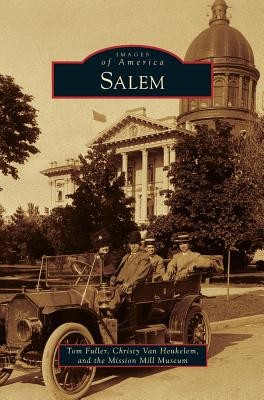
- We will send in 10–14 business days.
- Author: Tom Fuller
- Publisher: Arcadia Publishing Library Editions
- Year: 2009
- Pages: 130
- ISBN-10: 1531646840
- ISBN-13: 9781531646844
- Format: 17 x 24.4 x 1 cm, kieti viršeliai
- Language: English
- SAVE -10% with code: EXTRA
Reviews
Description
Long before the city of Salem got its name, the lush valley was a favorite winter camping location for the Kalapuya tribe. Jason Lee first ventured to Oregon in 1834, at the invitation of Northwest tribes, creating a mission and a settlement here. Native Americans called it "Chemeketa." William H. Willson, who laid out the city plan in 1851, called it "Salem." Both words mean "peace." Salem's central location, in the middle of the Willamette Valley's agricultural belt, made it an ideal location for the new capital of Oregon. Since then, Salem's character has largely been influenced by the presence of woolen mills, crop production, and many state institutions. Surviving devastating floods and fires in all three state capitol buildings, Salem and its people have a history of resilience, leadership, and public service.
EXTRA 10 % discount with code: EXTRA
The promotion ends in 22d.10:40:57
The discount code is valid when purchasing from 10 €. Discounts do not stack.
- Author: Tom Fuller
- Publisher: Arcadia Publishing Library Editions
- Year: 2009
- Pages: 130
- ISBN-10: 1531646840
- ISBN-13: 9781531646844
- Format: 17 x 24.4 x 1 cm, kieti viršeliai
- Language: English English
Long before the city of Salem got its name, the lush valley was a favorite winter camping location for the Kalapuya tribe. Jason Lee first ventured to Oregon in 1834, at the invitation of Northwest tribes, creating a mission and a settlement here. Native Americans called it "Chemeketa." William H. Willson, who laid out the city plan in 1851, called it "Salem." Both words mean "peace." Salem's central location, in the middle of the Willamette Valley's agricultural belt, made it an ideal location for the new capital of Oregon. Since then, Salem's character has largely been influenced by the presence of woolen mills, crop production, and many state institutions. Surviving devastating floods and fires in all three state capitol buildings, Salem and its people have a history of resilience, leadership, and public service.


Reviews